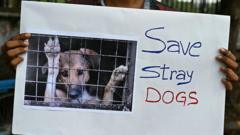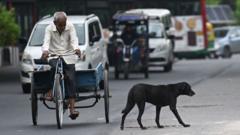The Nuremberg Zoo in southern Germany has ignited widespread outrage after the culling of 12 healthy Guinea baboons, a response attributed to severe overcrowding within their enclosure. Following the zoo's announcement of the culling, seven animal rights activists were arrested for staging a protest, with one demonstrator even gluing her hands to the ground at the entrance.
The zoo explained that overcrowding led to increased conflicts among the baboon population and that alternatives for re-housing the animals were not viable. Christoph Maisack, head of the German Legal Association for Animal Protection Law, condemned the culling, arguing that allowing the baboons to breed excessively does not justify their death.
This culling decision had been anticipated by the zoo for over a year, as its population of Guinea baboons surpassed 40, exceeding the capacity of their facility designed for 25, completed in 2009. Attempts to relocate the animals to other zoos fell through, as those institutions were also at capacity, and the zoo's contraceptive strategies had proven ineffective.
On the day of the culling, the zoo temporarily closed for "operational reasons," prompting demonstrators to breach its perimeter in protest. After confirming the execution of the baboons—none of whom were pregnant or involved in scientific studies—the zoo stated that the animals were shot, with samples taken for research purposes, and their remains subsequently fed to other predators housed within the zoo.
Dag Encke, the zoo's director, justified the drastic measure as a necessary last resort to regulate population numbers, adhering to European Association of Zoos and Aquaria (EAZA) guidelines. However, animal rights organizations have launched a criminal complaint against the zoo for the culling of healthy animals, asserting that this was an avoidable and illegal act, rooted in decades of reckless breeding practices.
This incident follows a pattern of controversial animal management decisions by zoos in Europe, including a notorious case in 2014 when a Copenhagen zoo culled a giraffe due to genetic similarities within its breeding program. The hostility toward these practices raises pertinent questions surrounding animal welfare, ethics in captivity, and the responsibilities of zoos to manage their populations humanely.





















